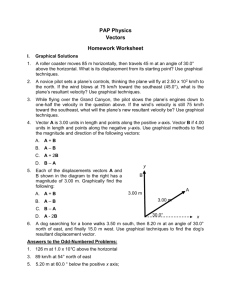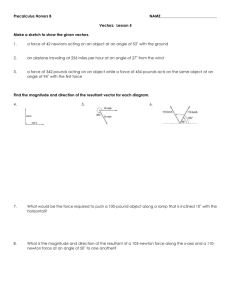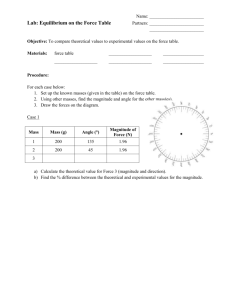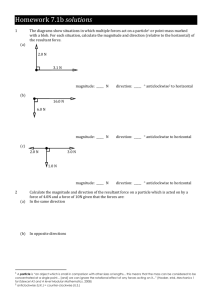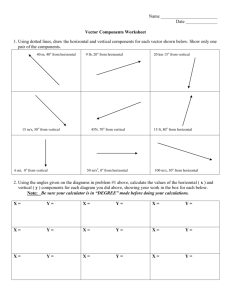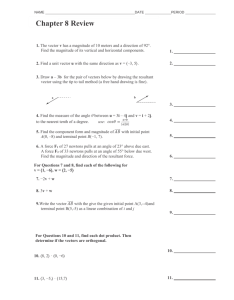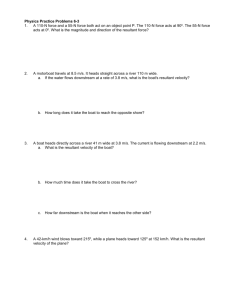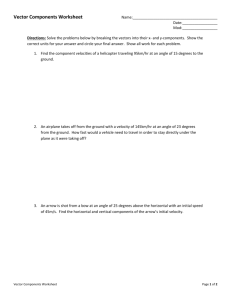Vectors Homework Worksheet: Physics Problems
advertisement
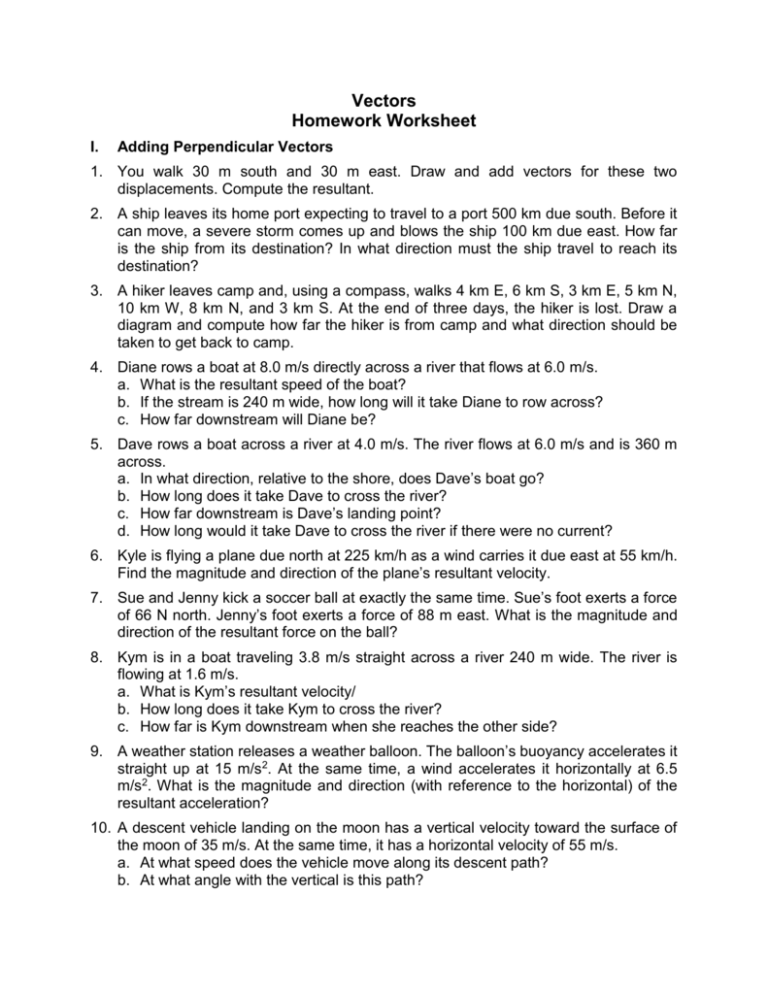
Vectors Homework Worksheet I. Adding Perpendicular Vectors 1. You walk 30 m south and 30 m east. Draw and add vectors for these two displacements. Compute the resultant. 2. A ship leaves its home port expecting to travel to a port 500 km due south. Before it can move, a severe storm comes up and blows the ship 100 km due east. How far is the ship from its destination? In what direction must the ship travel to reach its destination? 3. A hiker leaves camp and, using a compass, walks 4 km E, 6 km S, 3 km E, 5 km N, 10 km W, 8 km N, and 3 km S. At the end of three days, the hiker is lost. Draw a diagram and compute how far the hiker is from camp and what direction should be taken to get back to camp. 4. Diane rows a boat at 8.0 m/s directly across a river that flows at 6.0 m/s. a. What is the resultant speed of the boat? b. If the stream is 240 m wide, how long will it take Diane to row across? c. How far downstream will Diane be? 5. Dave rows a boat across a river at 4.0 m/s. The river flows at 6.0 m/s and is 360 m across. a. In what direction, relative to the shore, does Dave’s boat go? b. How long does it take Dave to cross the river? c. How far downstream is Dave’s landing point? d. How long would it take Dave to cross the river if there were no current? 6. Kyle is flying a plane due north at 225 km/h as a wind carries it due east at 55 km/h. Find the magnitude and direction of the plane’s resultant velocity. 7. Sue and Jenny kick a soccer ball at exactly the same time. Sue’s foot exerts a force of 66 N north. Jenny’s foot exerts a force of 88 m east. What is the magnitude and direction of the resultant force on the ball? 8. Kym is in a boat traveling 3.8 m/s straight across a river 240 m wide. The river is flowing at 1.6 m/s. a. What is Kym’s resultant velocity/ b. How long does it take Kym to cross the river? c. How far is Kym downstream when she reaches the other side? 9. A weather station releases a weather balloon. The balloon’s buoyancy accelerates it straight up at 15 m/s2. At the same time, a wind accelerates it horizontally at 6.5 m/s2. What is the magnitude and direction (with reference to the horizontal) of the resultant acceleration? 10. A descent vehicle landing on the moon has a vertical velocity toward the surface of the moon of 35 m/s. At the same time, it has a horizontal velocity of 55 m/s. a. At what speed does the vehicle move along its descent path? b. At what angle with the vertical is this path? Vector Homework Worksheet, page 2 II. Equilibrium 11. A net force of 55 N acts due west on an object. What added single force on the object produces equilibrium? 12. Two forces act on an object. One force is 6.0 N horizontally. The second force is 8.0 N vertically. a. Find the magnitude and direction of the resultant. b. If the object is in equilibrium, find the magnitude and direction of the force that produces equilibrium. 13. A 62-N force acts at 30.0 and a second 62-N force acts at 60.0. a. Determine the resultant force. b. What is the magnitude and direction of the force that produces equilibrium? 14. Two forces act on an object. A 36N force acts at 225. A 48-N force acts at 315. What would be the magnitude and direction of their equilibrant? III. Resolution of Vectors 15. Dan applies a force of 92 N on a heavy box by using a rope held at an angle of 45 with the horizontal. What are the vertical and horizontal components of the 92-N force? 16. Beth, a construction worker, attempts to pull a stake out of the ground by pulling on a rope that is attached to the stake. The rope makes an angle of 60.0 with the horizontal. Beth exerts a force of 125 N on the rope. What is the magnitude of the upward component of the force acting on the stake? 17. A street lamp weighs 150 N. It is supported equally by two wires that form an angle of 120 with each other. a. What is the tension of each of these wires? b. If the angle between the wires is reduced to 90.0, what new force does each wire exert? c. As the angle between the wires decrease, what happens to the force in the wire? 18. A water skier is towed by a speedboat. The skier moves to one side of the boat in such a way that the tow rope forms an angle of 55 with the direction of the boat. The tension on the rope is 350 N. What would be the tension on the rope if the skier were directly behind the boat? 19. Wendy pushes a laws spreader across a lawn by applying a force of 95 N along the handle that makes an angle of 60 with the horizontal. a. What are the horizontal and vertical components of the force? b. The handle is lowered so it makes an angle of 30.0 with the horizontal. Now what are the horizontal and vertical components of the force? 20. A person weighs 612 N. If the person sits in the middle of a hammock that is 3.0 m long and sags 1.0 m below the points of support, what force would be exerted by each of the two hammock ropes? Vector Homework Worksheet, page 3 III. Gravitational Forces and the Inclined Plane 21. A 562-N trunk is placed on an inclined plane that forms a 66 angle with the horizontal. a. Calculate the values of the parallel and perpendicular force components. b. If the angle of the incline is reduced to 30, what are the parallel and perpendicular components? 22. A car weighing 1.2 x 104 N is parked on a 36 slope. a. Find the force tending to cause the car to roll down the hill. b. What is the force that the car exerts perpendicular to the hill? 23. You place a box weighing 215 N on an inclined plane that makes a 35.0 angle with the horizontal. Compute the component of the gravitational force acting down the inclined plane. 24. A box weighing 431 N is placed on a plane inclined at 50 with the horizontal. Find the components of the weight that are parallel and perpendicular to the plane.
